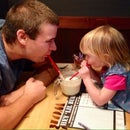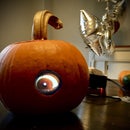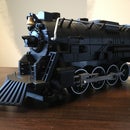Introduction: Pipe Shelving
Sick of box store beaver puke, press board shelving?
Why not make some customized shelves out of metal, real wood and looks pretty unique?
I needed a set of shelves in the "office", also known as (according to my wife), my computer junk room.
A perfect opportunity to built a set of pipe shelves that can be expanded onto as the need arises!
Step 1: Design and Raw Meterials
I wanted 3 shelves, 10" to 12" deep and around 34" in length.
Using my amazing CAD like doodle skills I sketched out the piping requirements.
Since the shelves were not going to holding anything crazy heavy, I opted to use pine (light, softwood) and hold them in place by sandwiching each board between two pipe couplers. No need for a length of pipe supporting the underside of each shelf.
I used 1/2" black steel pipe, mostly because it's readily available, is strong and is cheap. :)
The couplers themselves would be joined inside the board by a short pipe nipple, passing through a 7/8" hole drilled in each end of the board. This allows the couplers to tighten together along the nipple and pinch the board securely.
At the hardware store, 10" shelf pine was on sale, so 10" it was.
I cut the pine board into equal lengths of 34"
Because I knew that the board had a total depth of 10", I could now select the appropriate length of pipe coming out of the flange (against the wall) to bring the 90˚ elbow to the center of the board so the vertical pipes and couplers would support it evenly.
Here's a list of the materials I purchased to build 3 shelves, each with a length of 34" and a depth of 10", supported by two vertical pipe runs, screwed into wall studs at the top and bottom flange:
MATERIALS
1" x 10" x 8' pine shelving x 2 (the shelf boards)
1/2" x 1 1/2" black steel nipple x 6 (connects couplers through hole in each board)
1/2" x 2 1/2" black steel nipple x 4 (TOP: elbow to first coupling, BOTTOM: last coupling to elbow)
1/2" x 4" black steel nipple x 4 (flange to elbow)
1/2" floor flange x 4 (connects the wall stud to the pipes) :)
1/2" 90˚ black steel elbow x 4 (the elbows...)
1/2" black steel coupler x 12 (for sandwiching each of the 3 boards)
1/2" x 10" black steel length x 4 (the shelf space itself)
Whatever stain or pain you want
Step 2: I Can't Log Into My Router, But It Makes Great Grooves !
Now that you have all the bits and pieces and you've cut your shelf boards to length, let's fancy them up a bit by throwing a profile on the edges.
I did the front face and each side, leaving the back wall side of the boards square.
Since I'm just using pine, I stained each board with leftover strain I found in our storage closet.
Step 3: No Stud Finder Jokes Please... :)
Use a handy-dandy stud finder and located two studs significantly apart for the span of your shelf boards.
You don't want them too close together or the ends of your boards won't be supported.
You'll find most homes have studs on 16" centers, so I could have used 32" and spanned 3 studs. However, in my case I was able to use additional framing that's supporting the bulkhead above the shelf to have a 24" span on a 34" board length.
I attached the two top flanges with only a single screw into each stud so I could make minor adjustments to accommodate leveling. Once all the pieces were assemble, I put in the rest of the screws.
I measured out the hole location in the top board, then used a 7/8" spade bit in my drill press.
This fit the 1/2" x 1 1/2" pipe nipple perfectly, allowing the abutting couplers to sandwich the board and hold it firmly.
Once the first board is done and fits your two pipes correctly, you can simply use it as a temple for the holes on the other shelf boards.
I decided to be fancy and offset the top and bottom boards by 6" while leaving the center board well.. centered. :)
Step 4: DONE! Happy Dusting!
That's it!
By now you should have an attractive, unique and totally custom set of pipe shelves to call your own.
You can see how by utilizing additional pipe fittings (t-connectors are your friend) you could add additional shelves, valves, even lighting elements to your shelving project.
I plan on adding a second offshoot set of shelves along the wall under the window in the near future, when I get more free time (ha!).
Questions, comments, suggestions PLEASE send me a message or leave a comment!
Thanks for reading!
Take care.
P.S. The pictured 1936 Deforest Crosley radio is my next restoration project... stay tuned! :)











